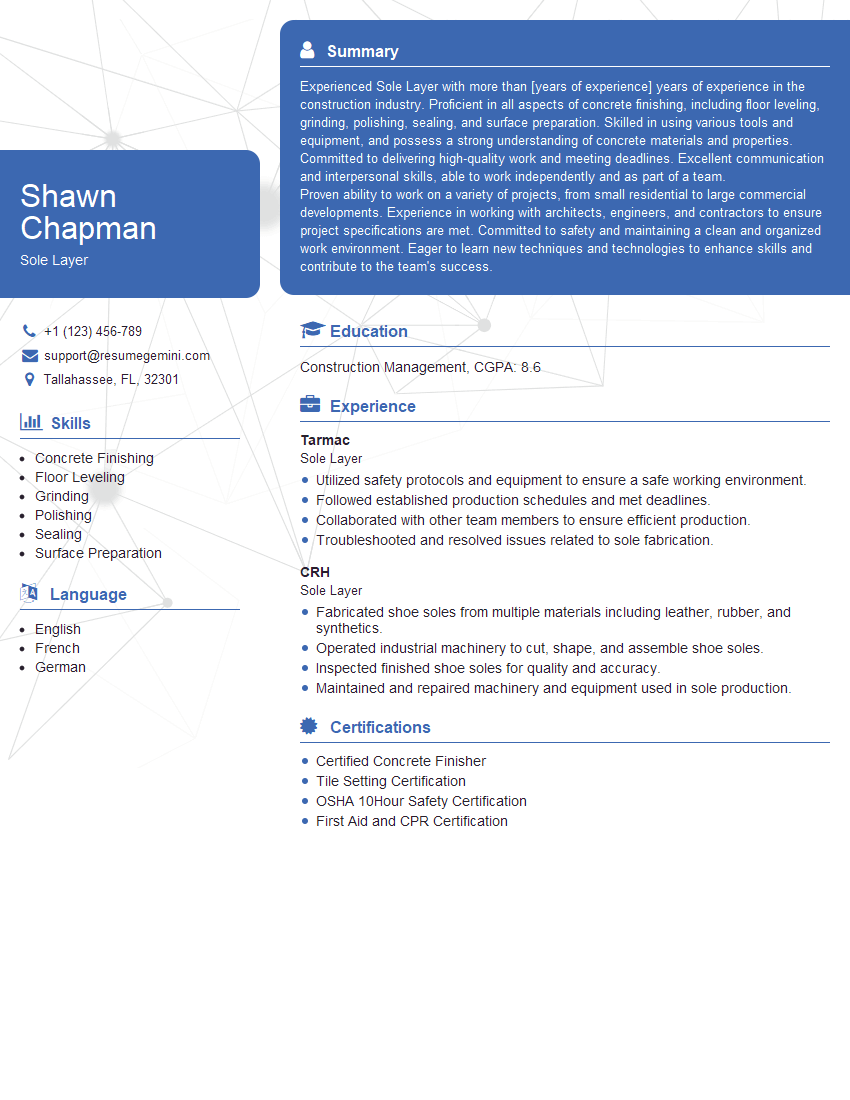Are you a seasoned Sole Layer seeking a new career path? Discover our professionally built Sole Layer Resume Template. This time-saving tool provides a solid foundation for your job search. Simply click “Edit Resume” to customize it with your unique experiences and achievements. Customize fonts and colors to match your personal style and increase your chances of landing your dream job. Explore more Resume Templates for additional options.

Shawn Chapman
Sole Layer
Summary
Experienced Sole Layer with more than [years of experience] years of experience in the construction industry. Proficient in all aspects of concrete finishing, including floor leveling, grinding, polishing, sealing, and surface preparation. Skilled in using various tools and equipment, and possess a strong understanding of concrete materials and properties. Committed to delivering high-quality work and meeting deadlines. Excellent communication and interpersonal skills, able to work independently and as part of a team.
Proven ability to work on a variety of projects, from small residential to large commercial developments. Experience in working with architects, engineers, and contractors to ensure project specifications are met. Committed to safety and maintaining a clean and organized work environment. Eager to learn new techniques and technologies to enhance skills and contribute to the team’s success.
Education
Construction Management
March 2016
Skills
- Concrete Finishing
- Floor Leveling
- Grinding
- Polishing
- Sealing
- Surface Preparation
Work Experience
Sole Layer
- Utilized safety protocols and equipment to ensure a safe working environment.
- Followed established production schedules and met deadlines.
- Collaborated with other team members to ensure efficient production.
- Troubleshooted and resolved issues related to sole fabrication.
Sole Layer
- Fabricated shoe soles from multiple materials including leather, rubber, and synthetics.
- Operated industrial machinery to cut, shape, and assemble shoe soles.
- Inspected finished shoe soles for quality and accuracy.
- Maintained and repaired machinery and equipment used in sole production.
Certificates
- Certified Concrete Finisher
- Tile Setting Certification
- OSHA 10Hour Safety Certification
- First Aid and CPR Certification
Languages
- English
- French
- German
Career Expert Tips:
- Select the ideal resume template to showcase your professional experience effectively.
- Master the art of resume writing to highlight your unique qualifications and achievements.
- Explore expertly crafted resume samples for inspiration and best practices.
- Build your best resume for free this new year with ResumeGemini. Enjoy exclusive discounts on ATS optimized resume templates.
How To Write Resume For Sole Layer
- Highlight your skills and experience: In your resume, clearly state your skills and experience related to sole layer job such as concrete finishing, floor leveling, grinding, polishing, sealing, and surface preparation. Quantify your accomplishments with specific examples whenever possible.
- Showcase your knowledge of concrete materials and properties: Demonstrate your understanding of different types of concrete mixes, their properties, and how they affect the finished product. This shows potential employers that you have a strong foundation in the field.
- Emphasize your attention to detail: Concrete finishing requires precision and attention to detail. In your resume, highlight your ability to consistently deliver high-quality work that meets specifications.
- Certify your skills: Consider obtaining industry-recognized certifications, such as the American Concrete Institute’s Concrete Flatwork Finisher or Trowel Trades Journeyworker certifications. Certifications provide credibility and demonstrate your commitment to professional development.
Essential Experience Highlights for a Strong Sole Layer Resume
- Prepare concrete surfaces for finishing by grinding, leveling, and patching.
- Lay and finish concrete floors, ensuring proper leveling, smoothness, and slope.
- Apply sealants and coatings to protect and enhance the durability of concrete surfaces.
- Operate and maintain a variety of floor finishing equipment, including grinders, polishers, and sealers.
- Inspect finished concrete surfaces to ensure they meet specifications and industry standards.
- Troubleshoot and resolve problems that arise during the concrete finishing process.
Frequently Asked Questions (FAQ’s) For Sole Layer
What are the key responsibilities of a sole layer?
Sole layers are responsible for preparing concrete surfaces, laying and finishing concrete floors, applying sealants and coatings, operating and maintaining floor finishing equipment, inspecting finished concrete surfaces, and troubleshooting and resolving problems that arise during the concrete finishing process.
What skills are required to be a successful sole layer?
To be a successful sole layer, you will need strong skills in concrete finishing, floor leveling, grinding, polishing, sealing, and surface preparation. You should also be proficient in using various tools and equipment, and possess a strong understanding of concrete materials and properties.
What are the career prospects for sole layers?
Sole layers can find employment in various industries, including construction, manufacturing, and transportation. With experience and additional training, you can advance to supervisory or management roles.
How can I improve my skills as a sole layer?
To improve your skills as a sole layer, consider obtaining industry-recognized certifications, such as the American Concrete Institute’s Concrete Flatwork Finisher or Trowel Trades Journeyworker certifications. You can also seek opportunities to work on different types of projects and gain experience in various concrete finishing techniques.
What is the average salary for a sole layer?
The average salary for a sole layer can vary depending on factors such as experience, location, and the size of the company. According to Salary.com, the average salary for a sole layer in the United States is around $45,000 per year.
What are the benefits of working as a sole layer?
Working as a sole layer offers several benefits, including job security, the opportunity to work outdoors, and the satisfaction of seeing your work completed. Sole layers also have the potential to earn a good salary and benefits.
What are the challenges of working as a sole layer?
Working as a sole layer can also present some challenges, such as working in all types of weather conditions, dealing with heavy equipment, and exposure to dust and fumes. Sole layers may also need to work long hours and weekends to meet project deadlines.